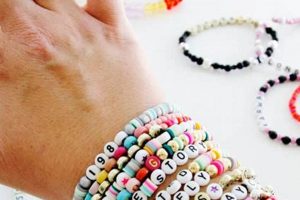Crafting personalized adornments for keys using beads is a prevalent recreational activity. Such projects involve stringing beads of varying materials, colors, and sizes onto a cord or wire, then attaching the beaded strand to a keyring. The resultant product functions as a distinctive and aesthetically pleasing key identifier. For example, individuals might create a keychain with beads that reflect their favorite sports team colors or incorporate beads that hold sentimental value.
The creation of customized keychains offers several advantages. It allows for self-expression and the development of fine motor skills. Furthermore, it provides a cost-effective and personalized gift-giving option. The practice of embellishing personal items with beads dates back centuries, with evidence of beaded accessories found in numerous ancient cultures. This enduring appeal highlights the timeless nature of handcrafted ornamentation.
An exploration of different beading techniques, material choices, and design inspirations provides a comprehensive understanding of creating unique keychains. Examining various bead types, stringing methods, and closure mechanisms enables the construction of durable and visually appealing accessories. Inspiration can be drawn from diverse sources, including nature, geometric patterns, and cultural motifs.
Essential Considerations for Beaded Keychain Construction
The creation of durable and aesthetically pleasing keychains from beads necessitates careful planning and execution. Attention to detail throughout the process ensures a lasting and functional accessory.
Tip 1: Material Selection: Prioritize beads constructed from robust materials like glass, stone, or high-quality acrylic. These exhibit greater resistance to wear and breakage than less durable alternatives.
Tip 2: Cord Strength: Employ a beading cord or wire specifically designed for jewelry making. Its tensile strength must be sufficient to withstand daily use and prevent premature failure.
Tip 3: Secure Knotting: Utilize proven knotting techniques, such as surgeon’s knots or square knots, to securely fasten the beads and prevent unraveling. Reinforce knots with a small amount of jewelry adhesive for added security.
Tip 4: Bead Arrangement: Plan the bead sequence meticulously to achieve a balanced and visually appealing design. Consider the interplay of colors, shapes, and sizes to create a harmonious aesthetic.
Tip 5: Closure Mechanisms: Select a keyring or clasp that is appropriate for the size and weight of the finished keychain. Ensure the closure mechanism is robust and reliable to prevent accidental key detachment.
Tip 6: Avoiding Overcrowding: Refrain from excessively packing beads onto the cord or wire. Overcrowding can compromise the cord’s integrity and create an unwieldy or uncomfortable keychain.
Tip 7: Protective Coatings: Apply a sealant or varnish specifically formulated for jewelry to protect the beads from scratches, fading, and environmental damage. This can extend the lifespan of the keychain.
Adhering to these guidelines promotes the creation of enduring and attractive keychains. Consideration of material properties, construction techniques, and design principles is paramount for achieving a successful outcome.
With proper execution of techniques and design, the outcome is a visually impressive and durable accessory.
1. Bead Material Selection
The selection of bead materials directly influences the longevity, aesthetic appeal, and overall suitability of beaded keychains. This choice is not merely a matter of visual preference; it is a critical determinant of the accessory’s ability to withstand daily wear and tear. The materials employed dictate the keychain’s resistance to abrasion, impact, and environmental factors such as moisture and UV exposure. For instance, a keychain constructed with glass or gemstone beads exhibits superior durability compared to one made with plastic or acrylic beads, demonstrating a direct cause-and-effect relationship. Understanding this material property is a foundational element of crafting enduring keychains.
The practical significance of informed material selection extends beyond durability. The aesthetic qualities of the beads significantly impact the keychain’s overall visual impact. Glass and gemstone beads offer a greater range of colors, textures, and finishes, allowing for more sophisticated and nuanced designs. Metal beads, whether solid or plated, introduce a different dimension, offering opportunities to incorporate metallic accents and create a more contemporary aesthetic. Real-world examples include the use of durable, ethically sourced wooden beads for a rustic, nature-inspired design, or the selection of semi-precious stones to create a more luxurious and personalized keychain.
In conclusion, bead material selection is an essential factor in constructing beaded keychains. It is not merely an aesthetic choice, but a functional decision impacting the accessory’s longevity and overall value. Overlooking material properties can lead to premature wear, breakage, and ultimately, a diminished appreciation for the handcrafted item. A comprehensive understanding of bead characteristics and their implications for durability and aesthetics is, therefore, paramount for successful creation of durable and visually interesting beaded keychains.
2. Stringing Method Variations
The selection of a suitable stringing method constitutes a critical juncture in the crafting of beaded keychains. Stringing method directly influences the structural integrity, flexibility, and aesthetic presentation of the finished product. An inadequate technique can result in premature breakage, unattractive gaps between beads, or an overall lack of durability.
- Single Strand Stringing
This technique involves threading beads onto a single cord. It is suitable for simpler designs with lightweight beads. Its primary advantage is its ease of execution, making it accessible to novice crafters. However, a single break in the cord can lead to complete disassembly of the keychain. This method is often observed in introductory crafting kits.
- Double Strand Stringing
Employing two parallel cords to string the beads increases the keychain’s tensile strength and resilience. Should one strand break, the second strand provides continued support, preventing immediate failure. This method is recommended for keychains utilizing heavier or irregularly shaped beads. The added support is vital for retaining structural integrity under daily use. An example of this method can be seen on keychains that incorporate natural gemstones.
- Knotting Between Beads
This labor-intensive method involves tying a knot after each bead is strung
. The primary benefit is that it prevents beads from sliding and bunching, maintaining a uniform appearance. Additionally, it isolates individual beads, limiting the impact of a cord break to a single bead. While more time-consuming, this method is advantageous for high-value keychains where maintaining bead spacing is paramount. One finds this implemented on high-end keychains. - Wire Wrapping
This technique involves using wire to secure individual beads, creating a more robust and intricate design. Wire wrapping is particularly well-suited for connecting beads of varying sizes and shapes, allowing for greater design flexibility. It offers superior durability compared to cord-based methods, rendering it suitable for heavy-duty keychains. Examples of this are found in steampunk or industrial-themed creations.
The choice of stringing method necessitates careful consideration of bead weight, desired aesthetic, and anticipated level of use. Failure to select an appropriate technique can compromise the keychain’s structural integrity and diminish its overall value. Stringing methods must be selected carefully so keychains are appealing and functional.
3. Color Palette Coordination
Color palette coordination holds a pivotal position within the sphere of crafting personalized keychains. The strategic selection and arrangement of colors exert a significant influence on the final product’s visual appeal and perceived value. Ineffective coordination can result in a discordant and aesthetically displeasing outcome, while thoughtful arrangement elevates the keychain from a mere functional item to a statement piece. The ability to harmonize colors effectively contributes directly to the perceived quality of the keychain. Examples include the deliberate use of complementary colors, such as blue and orange, to create visual contrast, or the implementation of analogous color schemes, utilizing hues adjacent on the color wheel for a more harmonious effect. These actions are the essence of this principle.
The practical application of color theory extends beyond mere aesthetics. Color psychology suggests that certain color combinations evoke specific emotions or associations. A keychain intended as a gift for a nature enthusiast, for example, might incorporate earthy tones like greens and browns to resonate with their appreciation for the outdoors. Conversely, a keychain designed to promote energy and vitality might utilize vibrant colors like red, yellow, and orange. Understanding the psychological impact of color allows for the creation of keychains that communicate specific messages or align with particular preferences. An example can be seen with university keychains, that use university colors to convey school spirit.
In summary, color palette coordination is an indispensable element in the process of crafting personalized keychains. It is a critical component in creating aesthetically pleasing and meaningful accessories. By considering the principles of color theory and the psychological impact of colors, crafters can elevate their creations from simple functional items to cherished personalized expressions. Overlooking color coordination can greatly diminish visual impact, but thoughtful coordination greatly enhances visual effects. Color coordination is very impactful, that is undeniable.
4. Closure Mechanism Security
The integrity of a beaded keychain hinges significantly on the reliability of its closure mechanism. This component serves as the crucial link between the decorative beaded element and the functional aspect of securing keys. Failure of the closure mechanism negates the keychain’s purpose and potentially leads to the loss of valuable keys. Therefore, careful selection and secure attachment of the closure are paramount in the creation of durable and functional beaded keychains. This point cannot be overlooked.
- Keyring Material and Construction
The keyring, typically made of metal, must possess sufficient strength to withstand constant manipulation and the weight of multiple keys. Inferior materials or poorly constructed rings can bend, break, or lose their spring tension, compromising security. Examples include split ring keyrings made from tempered steel versus those constructed from weaker alloys. Temperd steel is much stronger and reliable.
- Clasp Type and Functionality
Various clasp designs, such as lobster clasps, swivel clasps, and spring gate rings, offer different levels of security and ease of use. Lobster clasps, for instance, provide a secure closure but may be difficult to operate with one hand. The selection should align with the intended use and user dexterity. Clasps constructed from plated metal can be prone to deterioration, while those with proper material selection are more reliable.
- Attachment Method Security
The method used to connect the beaded element to the keyring or clasp is critical. Weak or improperly secured connections, such as loosely tied knots or poorly crimped wire, can fail under stress. Using techniques like secure knots reinforced with adhesive, or correctly crimping wire ends with appropriate tools, are vital. This provides a secure point that prevents slippage. Without it, all falls apart.
- Testing and Quality Assurance
Prior to completing the keychain, a stress test of the closure mechanism is advisable. This involves applying a reasonable amount of force to simulate real-world conditions and identify potential weaknesses. Repeating tugging and pulling will help determine the point of possible failure. This step also ensures that keys are safe and will not fall off. Quality controls are paramount to quality.
The longevity and functionality of beaded keychains are inextricably linked to the security of their closure mechanisms. Careful consideration of material quality, clasp design, attachment methods, and rigorous testing are crucial steps in ensuring the keychain effectively serves its purpose of safeguarding keys. The failure to consider these factors creates a keychain that is both unreliable and potentially worthless.
5. Pattern Complexity Control
Pattern complexity control represents a critical aspect of crafting beaded keychains, directly impacting both the aesthetic appeal and the structural integrity of the finished product. The deliberate management of pattern complexity dictates the visual coherence and the intricacy of the design, and consequently, influences the overall success of the project. Uncontrolled complexity can lead to a visually chaotic and structurally unstable keychain, while overly simplistic patterns may lack visual interest. Therefore, thoughtful consideration of pattern complexity is essential for achieving a balanced and aesthetically pleasing outcome. For instance, a novice crafter might start with simple alternating color patterns before progressing to more elaborate geometric designs. Complexity is a scale and not something to scoff at.
The practical significance of pattern complexity control is evident in diverse design approaches. A minimalist approach, characteriz
ed by simple repeating patterns and limited color palettes, emphasizes elegance and understated sophistication. This approach might involve using only two or three different bead types arranged in a regular sequence. Conversely, a more intricate design might incorporate a wide array of bead sizes, shapes, and colors, arranged in complex geometric or organic patterns. However, even in these more complex designs, the underlying structure must be carefully controlled to prevent the keychain from appearing cluttered or disorganized. An uncontrolled design is simply a mess, and this fact is undeniable.
In conclusion, pattern complexity control is an indispensable element in creating personalized keychains. It serves as a crucial determinant of visual impact and structural stability. Mastering this element enables crafters to translate their creative vision into tangible, aesthetically pleasing, and durable accessories. Challenges in pattern complexity arise most frequently among beginners, who have not yet learned to refine their methods. In the same vein, experienced crafters face an entirely different, but related challenge: innovating patterns that are complex and unique. Pattern complexity is not to be ignored, if the final product is to be visually impressive.
6. Personalized Theme Integration
Personalized theme integration, in the context of creating beaded keychains, constitutes the deliberate incorporation of specific motifs, symbols, or design elements that reflect an individual’s interests, affiliations, or significant experiences. This process transcends mere aesthetic embellishment; it transforms a functional item into a personal statement, imbued with meaning and emotional resonance. The success of this integration relies on a clear understanding of the intended recipient’s preferences and the skillful translation of those preferences into a cohesive and visually appealing design. It becomes a tangible manifestation of personal identity.
- Hobbies and Interests
The integration of hobbies and interests into beaded keychain designs offers a direct avenue for personalization. Miniature representations of sporting equipment, musical instruments, or artistic tools can be incorporated into the bead arrangement. For instance, a keychain designed for a cyclist might feature small bicycle charms or beads arranged in patterns reminiscent of tire treads. Real-world examples of this include a musician having a keychain with small music notes or a hiker with a carabiner and outdoor-themed beads. Such implementations enhance the keychain’s relevance and appeal to the individual, reflecting the person in accessory form.
- Affiliations and Memberships
Affiliations and memberships, be they to academic institutions, social clubs, or professional organizations, provide a rich source of thematic inspiration. Colors, logos, or symbolic representations associated with these groups can be integrated into the keychain design. For example, a keychain created for a university alumnus might feature the university’s colors and mascot. Keychains can also represent various social groups or organizations. This not only expresses loyalty but also serves as a subtle identifier within the affiliated community, creating a sense of belonging.
- Significant Events and Memories
Commemorating significant events and memories through beaded keychains allows for the creation of tangible keepsakes. Dates, initials, or symbolic representations of key milestones, such as graduations, weddings, or anniversaries, can be incorporated into the design. A keychain commemorating a special travel experience might include beads representing landmarks visited or colors evocative of the destination. Often used as gifts that are more than material but have sentimental value and become memorable.
- Personal Mottos and Inspirations
The integration of personal mottos and inspirational phrases offers a unique form of personalized theme integration. Letter beads or engraved charms can be used to spell out meaningful words or phrases. These can be displayed to convey a message of motivation, affirmation, or personal philosophy. A keychain bearing an empowering quote can serve as a daily reminder and a source of inspiration for the individual. They are both meaningful and functional, a practical piece, and a thought-provoking reminder.
By strategically incorporating these elements into beaded keychain designs, crafters can create items that are not only aesthetically pleasing but also deeply personal and meaningful. The act of personalization transforms a simple accessory into a cherished keepsake that reflects the individual’s identity, interests, and experiences. This thoughtful integration elevates the craft from a mere hobby to a form of personal expression and emotional connection, making DIY beaded keychains that more meaningful. The use of symbolism is what sets personalized beaded keychains apart from generic keychains.
7. Durability Enhancement Strategies
Durability enhancement strategies are crucial to the long-term viability and functionality of do-it-yourself beaded keychains. Without careful consideration of these strategies, handcrafted keychains are prone to premature wear, breakage, and overall dissatisfaction. Implementing such strategies extends the lifespan of these accessories and increases their practical value.
- Reinforced Cord Selection
The choice of cord material directly impacts the keychain’s resistance to tensile stress and abrasion. Utilizing high-strength synthetic cords, such as nylon or braided polyethylene, provides superior durability compared to weaker alternatives like cotton or elastic. Real-world examples include the use of paracord for its exceptional strength-to-weight ratio or specialized beading threads designed to resist fraying. This directly affects the keychain’s structural integrity.
- Protective Coating Application
Applying a protective coating to the finished keychain safeguards the beads and cord from environmental factors such as moisture, UV radiation, and physical abrasion. Sealants specifically formulated for jewelry or crafts create a barrier against these damaging elements. The use of acrylic sprays or varnishes, for example, can significantly reduce fading, scratching, and deterioration of the bead surfaces. This practice greatly extends visual appeal.
- Strategic Knotting Techniques
Employing secure and strategically placed knots minimizes the risk of bead slippage and cord unraveling. Knotting techniques such as surgeon’s knots, square knots, or overhand knots, when properly executed, provide robust connections that withstand repeated stress. Reinforcing these knots with adhesive further enhances their holding power and prevents loosening over time. An unsecured knot is the first step to disintegration.
- Metal Component Integration
Incorporating metal components, such as crimp beads, wire guards, and sturdy keyrings, strengthens the overall construction of the keychain. Crimp beads secure cord ends, preventing fraying and bead loss. Wire guards protect the cord from abrasion near the keyring attachment point. Selecting high-quality metal components resistant to corrosion ensures the longevity of these critical connections.
Without these elements, connections would soon fail.
The successful implementation of these durability enhancement strategies translates directly into higher quality and more resilient do-it-yourself beaded keychains. By prioritizing material selection, protective measures, secure construction techniques, and the integration of robust metal components, crafters can significantly extend the lifespan and functionality of their creations. The practice of durability, like any skillset, must be practiced to be achieved and perfected.
Frequently Asked Questions
The following section addresses common inquiries regarding the construction and design of beaded keychains. These questions are intended to provide clarity and guidance for individuals engaging in this craft.
Question 1: What bead materials offer the greatest durability for keychains?
Glass, stone, and high-quality acrylic beads exhibit superior resistance to wear and breakage compared to plastic or wooden alternatives. These materials withstand daily handling and environmental exposure more effectively.
Question 2: Which stringing methods provide the most secure bead attachment?
Double-strand stringing, knotting between beads, and wire wrapping techniques offer enhanced security compared to single-strand stringing. These methods distribute stress and prevent complete disassembly in the event of cord or wire failure.
Question 3: How can color palettes be effectively coordinated for visually appealing keychains?
Adherence to color theory principles, such as utilizing complementary or analogous color schemes, enhances visual harmony. Considering the psychological impact of different colors allows for the creation of keychains that evoke specific emotions or align with particular themes.
Question 4: What types of closure mechanisms offer the most reliable key security?
Keyrings constructed from tempered steel, along with lobster clasps or spring gate rings made from durable materials, provide secure key attachment. Regularly inspecting these mechanisms for signs of wear or damage is advisable.
Question 5: How can pattern complexity be managed to create balanced and aesthetically pleasing keychains?
Starting with simpler patterns and gradually increasing complexity allows for greater control over the final design. Maintaining a clear focal point and avoiding excessive bead overcrowding are crucial for achieving visual coherence.
Question 6: What are effective strategies for incorporating personalized themes into beaded keychains?
Integrating symbols or motifs related to hobbies, affiliations, significant events, or personal mottos adds meaning and emotional resonance. Careful consideration of the recipient’s preferences is essential for successful theme integration.
In summary, the construction of durable, visually appealing, and personalized beaded keychains requires careful attention to material selection, construction techniques, design principles, and the individual preferences of the recipient. These factors contribute directly to the overall quality and value of the finished product.
This concludes the frequently asked questions section. The following portion addresses the final conclusion.
diy beaded keychain ideas
The preceding analysis has explored diverse facets involved in constructing personalized keychains. Key considerations include the selection of durable materials, the application of secure stringing methods, the strategic coordination of color palettes, and the implementation of closure mechanisms. Furthermore, effective management of pattern complexity and the integration of personalized themes contribute significantly to the overall success of the project. These parameters collectively dictate the aesthetic appeal, structural integrity, and functional utility of the finished product.
The creation of personalized adornments represents a confluence of artistic expression and practical application. Mastery of the techniques and considerations outlined herein empowers individuals to craft unique and meaningful accessories. Continued exploration and refinement of these skills promise to yield increasingly sophisticated and valuable creations. The synthesis of artistic expression and practical considerations ensures the enduring relevance of this craft.







